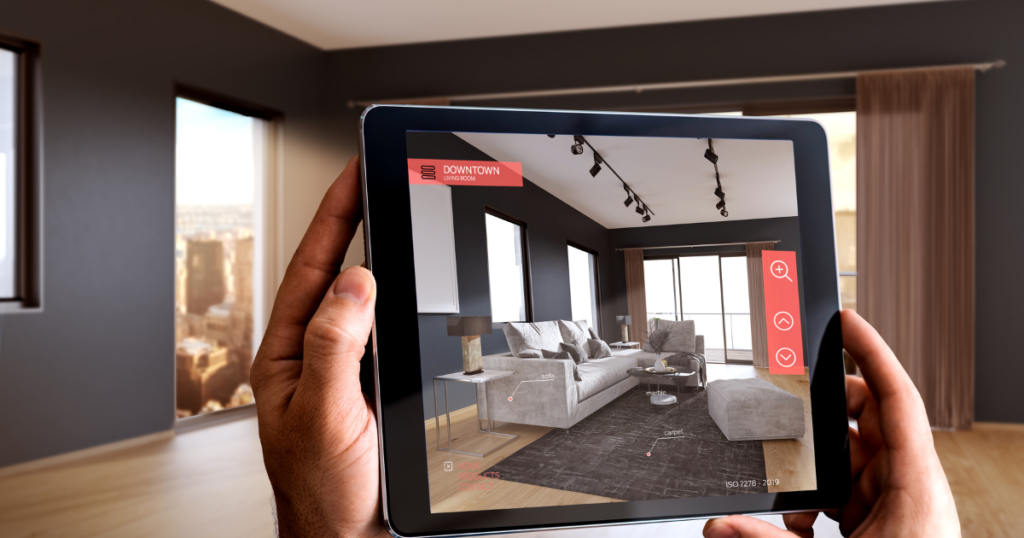The integration of Augmented Reality (AR) into real estate strategies presents a significant shift in how properties are marketed and sold. By allowing potential buyers to visualize changes and enhancements in real-time, AR not only enriches the buying experience but also streamlines decision-making processes. This technology is poised to reshape traditional real estate practices by offering immersive previews and interactive elements that were previously unimaginable. As we explore the depths of AR’s impact on the industry, one must consider how this digital innovation could potentially redefine market dynamics and customer engagement. What remains to be seen is how widely these practices will be adopted and their long-term effects on the global real estate market.
Understanding Augmented Reality
Augmented Reality (AR) frequently revolutionizes the way potential buyers interact with real estate properties by overlaying digital information onto the physical world, enhancing both visualization and interaction. This innovative AR technology enables real estate agents and companies to offer an interactive experience unlike any other.
Through the use of digital overlays, clients can engage with properties in a dynamic and immersive manner, making it easier to visualize the potential of a space without the need for physical presence.
These interactive experiences are made possible by AR technology, which integrates digital information seamlessly with real-world environments. This not only makes the viewing process more engaging but also allows for a personalized exploration of properties.
Potential buyers can manipulate elements within the digital overlays, such as altering layouts, swapping furniture, or modifying design features, all in real-time. This level of interaction provides a deeper connection to the property, aiding in decision-making and increasing the likelihood of a purchase.
AR in Property Visualization
In property visualization, AR technology overlays digital enhancements onto physical spaces, greatly enhancing the buyer’s understanding and interaction with potential properties. This integration of AR into real estate marketing allows potential buyers to visualize changes like furniture arrangements, color schemes, and even possible renovations directly within the physical space of the property.
This immediate and immersive experience can greatly influence buyer decisions by providing a customized and interactive view of the property’s potential without the need for actual, costly physical alterations.
Moreover, the use of AR in property visualization offers a distinctive advantage in real estate marketing. It transforms traditional property showings into engaging, interactive experiences where buyers can see beyond the current state of a property and imagine what it could become.
This capability not only enhances the attractiveness of properties but also drives deeper engagement and emotional connections with the space.
Interactive Marketing Strategies
Interactive marketing strategies employing AR technology are transforming the way real estate professionals engage with potential buyers. By integrating augmented reality, these strategies offer immersive experiences that not only captivate but also deeply engage customers in the property buying journey. AR tools enable potential buyers to tour properties virtually, providing a realistic sense of space and layout without physical presence. This level of interactivity greatly enhances customer engagement, making the process both efficient and enjoyable.
These interactive marketing strategies leverage AR to deliver personalized property showcases, allowing clients to visualize changes and possibilities within the space, tailored to their preferences. This customization fosters a stronger connection between the buyer and the property, increasing the likelihood of a sale.
Here is a breakdown of how AR enhances interactive marketing strategies in real estate:
| Feature | Benefit | Impact on Buyer Experience |
|---|---|---|
| Virtual Tours | Saves time and travel costs | Immersive and convenient |
| Customization | Tailors to buyer preferences | Increases emotional attachment |
| Real-time Info | Provides updated property data | Enhances decision-making |
Efficiency in Real Estate Sales
Building on these interactive elements, AR technology greatly streamlines the process of real estate sales by enhancing efficiency at multiple levels. Augmented reality in real estate transforms traditional sales strategies into dynamic, data-driven processes. By reducing the necessity for physical property tours, AR saves valuable time and financial resources, allowing real estate agents and clients to explore multiple listings more rapidly.
This efficiency in real estate sales not only accelerates the decision-making process but also cuts down notably on operational costs. Moreover, AR supports real estate professionals in utilizing data-driven strategies to better match properties with client preferences. This capability ensures that every interaction with a potential buyer is informed and efficient, focusing on properties that truly meet their needs and desires.
The integration of real-time data analytics further refines this process, enabling a more streamlined and responsive approach to sales. These technological advancements in AR provide real estate businesses with powerful tools to enhance their efficiency. By merging detailed property visualizations with market data, augmented reality offers a competitive edge in today’s fast-paced market, setting a new standard for efficiency and effectiveness in real estate sales strategies.
Personalized Customer Experiences
Augmented Reality (AR) greatly enhances personalized customer experiences in real estate by allowing real-time tailoring of digital content to individual buyer preferences. This technology empowers users to define specific criteria for their ideal residence, leading to a more personalized property search experience. By aligning virtual property showcases with these preferences, AR guarantees that each client’s interaction is uniquely suited to their needs and desires.
Personalized virtual tours facilitated by AR bring properties to life in ways traditional photos cannot. Clients can virtually navigate through properties that meet their defined criteria, experiencing each space as though they were physically present. This level of personalization not only captivates customer attention but also significantly boosts the likelihood of conversions. As these experiences are deeply tailored, potential buyers can better visualize themselves in the space, enhancing emotional engagement and decision-making confidence.
Moreover, AR supports data-driven strategies in real estate. It analyzes consumer behavior and preferences to refine the property matching process, ensuring a highly personalized experience. This approach not only streamlines the search process but also enhances satisfaction by consistently presenting buyers with options that resonate with their individual lifestyle and tastes.
Therefore, AR in real estate not only optimizes the buying journey but also elevates it to unprecedented levels of personalization and efficiency.
Implementing AR Technology
Implementing AR technology in the real estate sector allows professionals to offer virtual property tours, which are both immersive and resource-efficient. This innovative approach not only enhances the way properties are marketed but also revolutionizes the client interaction experience.
Through AR, potential buyers can engage in interactive property exploration, viewing detailed layouts and custom features with just a few taps on their devices. This method greatly reduces the need for physical site visits, saving time and operational costs.
Moreover, AR technology provides a platform for showcasing properties in dynamic, engaging ways. By overlaying digital information onto real-world environments, clients can visualize modifications and adaptations in real-time, making the property viewing experience highly immersive. This capability allows for a deeper connection between the buyer and the property, facilitating faster decision-making processes.
The integration of AR tools into real estate practices leads to more cost-efficient and effective marketing strategies. Real estate businesses that adopt this technology not only set themselves apart from competitors but also attract tech-savvy clients who appreciate innovation.
As a result, the implementation of AR not only boosts customer satisfaction but also drives sales, marking a significant advance in real estate marketing techniques.
Future Trends in AR Real Estate
Emerging trends in AR real estate, such as interactive floor plans and virtual property tours, are set to redefine the boundaries of property showcasing and client engagement. These innovative tools not only offer immersive experiences but also provide practical solutions for both realtors and clients. Virtual property tours allow potential buyers to explore properties remotely, reducing the need for physical visits. Interactive floor plans enable users to visualize space arrangements dynamically, enhancing their understanding and connection to the property.
Real-time property staging is another significant trend poised to transform the real estate market. This technology allows realtors to configure properties in real-time according to the preferences of potential buyers, providing a personalized experience that can have a substantial impact on purchasing decisions.
Here’s how these innovations are shaping the future:
Virtual Property Tours
- Benefit: Minimizes the necessity for in-person visits
- Impact on Industry: Enhances operational efficiency
Interactive Floor Plans
- Benefit: Improves spatial comprehension
- Impact on Industry: Elevates client interaction
Real-Time Property Staging
- Benefit: Customizes properties to match buyer preferences
- Impact on Industry: Increases conversion rates
These advancements promise not only to enhance customer satisfaction but also to drive the evolution of real estate strategies, fostering a more interactive and client-centric market environment.
Final Thoughts
To sum up, augmented reality is drastically transforming the landscape of real estate, marrying technology with traditional practices to foster enhanced visualizations and interactive customer engagements.
As AR technology continues to evolve, it promises not only to streamline property sales and reduce costs but also to personalize the buyer’s journey in unprecedented ways.
The anachronistic notion of static property viewing is quickly giving way to a dynamic, immersive experience, setting a new standard in real estate marketing and operations.


